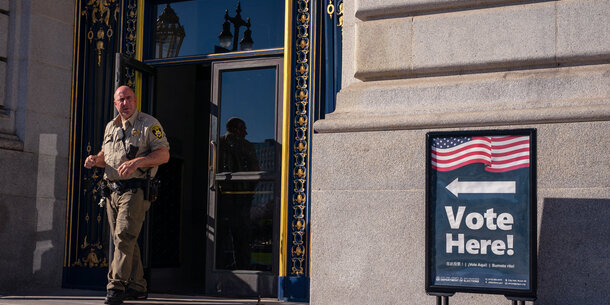Women, people of color, and young people are severely underrepresented in our governing institutions — just looking at a picture of the members of the Senate illustrates this fact. Recent headlines and research inspire enthusiasm about the increased numbers of members of these groups running for and serving in elected office. Still, financial and political barriers remain, making it more difficult for them to get into office and stay there.
For a new report, Intimidation of State and Local Officeholders: The Threat to Democracy, the Brennan Center, the Bridging Divides Initiative at Princeton University, and the Eagleton Center for Public Interest Polling at Rutgers University surveyed and interviewed local elected officials and state legislators across the country to get a better sense of the hostility and abuse they face. Experiences of intimidation are common among those in office: 43 percent of state legislators experienced threats during their last term and most recent campaign, and 18 percent of local officeholders faced threats within the prior three months. This abuse impedes the normal functioning of representative government, with more than 40 percent of local officeholders reporting that the hostility had chilled their desire to work on controversial topics or run for reelection or higher office.
The report found that these burdens are unequal: women and people of color experience outsize effects of hostility on their personal and public lives. On top of what the report highlights, the survey results contain additional disparities. First, the precautions that legislators take in response to hostility may be less accessible to those with lower incomes. Women of color in state and local office face disproportionate burdens from abuse, experiencing threats, hostility related to their appearance, and hostility of a sexual nature at especially high rates, which requires them to take inconvenient, resource-intensive precautions in response. And younger officeholders face higher rates of intimidation than older ones, reporting greater chilling effects on their engagement with public life. Intimidation makes it harder for these groups to run for and remain in office, therefore hampering their ability to create policy change on behalf of underrepresented communities.
The costs of responding to intimidation and abuse
In interviews, legislators shared a variety of tactics they used to protect themselves, mostly individual approaches taken on their own initiative. When asked whether they had taken specific precautions, such as moving homes, in response to hostility, lower-income state legislators reported doing so at considerably lower rates than higher-income ones — an unsurprising result given the costs of these measures. Since earnings for women of color and young people are lower on average than for men and older working-age adults, they may be at a disadvantage when it comes to being proactive against threats. These findings lend support to proposals to reduce the sometimes prohibitive costs of running for office, which would benefit lower-income candidates of all races and genders.
Hostility disproportionately impacts women of color and distorts representation
In addition to disparities in the abuse experienced by female versus male officeholders, larger gaps emerged when the group of women respondents was separated into white women and women of color. Some of the frequency and types of hostility faced by elected representatives were intersectional in character. While white women and men of color faced threats at a higher rate than white men, women of color experienced even higher rates.
Among local elected officials, women generally received hostile comments about their appearance at a higher rate than men — for women of color, the rate was even higher. Here, the disparity in rates between women of color and white men exceeded even the combined disparities between white women and men, and between men of color and white men. State legislators who were women of color also faced higher rates of hostility of a sexual nature, compared with white women and men. When asked whether they had taken various precautions to avoid hostility and abuse, women state legislators of color consistently reported taking them at far higher rates than other groups did.
Even as women of color reported taking life-disrupting precautions at such high rates, when the surveys asked whether they were less likely to run for reelection or higher office, they answered similarly to other groups. This aligned with what some state legislators told us in interviews — these disparities did not dissuade them from public service, and in some cases hardened their resolve to serve. Yet these women’s courage does not negate the concern that disparities degrade representation. The time, money, and energy spent addressing abuse could have been spent elsewhere. Furthermore, these findings reflect only the voices of those already in office, and many women of color may choose not to run or have a harder time succeeding because of the costs of doing so.
As of 2021, women of color constituted just 8 percent of state legislators and 6 percent of statewide executives. This does not just matter for descriptive reasons — that is, for the sake of elected officials’ identities better representing those of the general public — but also because that representation bears results. Political scientists have found that women of color in state legislatures are more likely to address the needs of communities marginalized along lines of class and race, such as through the preservation and expansion of social programs or the pursuit of criminal justice reform. Additionally, women in general are likelier than male legislators to legislate on issues such as abortion and childcare. When hostility deters members of marginalized communities from running and poses barriers to their ability to engage with and represent their citizens, it threatens democratic representation as a whole.
A barrier to younger generations entering politics
Among local elected officials, younger respondents consistently reported having been insulted, harassed, and threatened at higher rates than older ones. Younger local and state officials reported changing their behavior in their private and public lives in response to such hostility at higher rates. As more millennial and Gen Z candidates run for office, these unequal burdens pose a barrier to the political representation of younger Americans, whose positions on key issues ranging from abortion to climate change differ on average from their elders’.
The threat of political violence corrodes democratic norms no matter the gender, race, income, or age of its target. But when the amount of hostility — and severity of the consequences — fall disproportionately on groups that are already underrepresented in state and local government, it poses a threat to fair representation, both in terms of who is in office and the issues officeholders address. It is therefore all the more crucial that governments, parties, and officeholders act to tackle this issue. The recommendations offered in our report provide ways to better ensure that as a more socioeconomically diverse cohort of public servants enters government, they can safely and securely do what they came there to do: represent their constituents.











